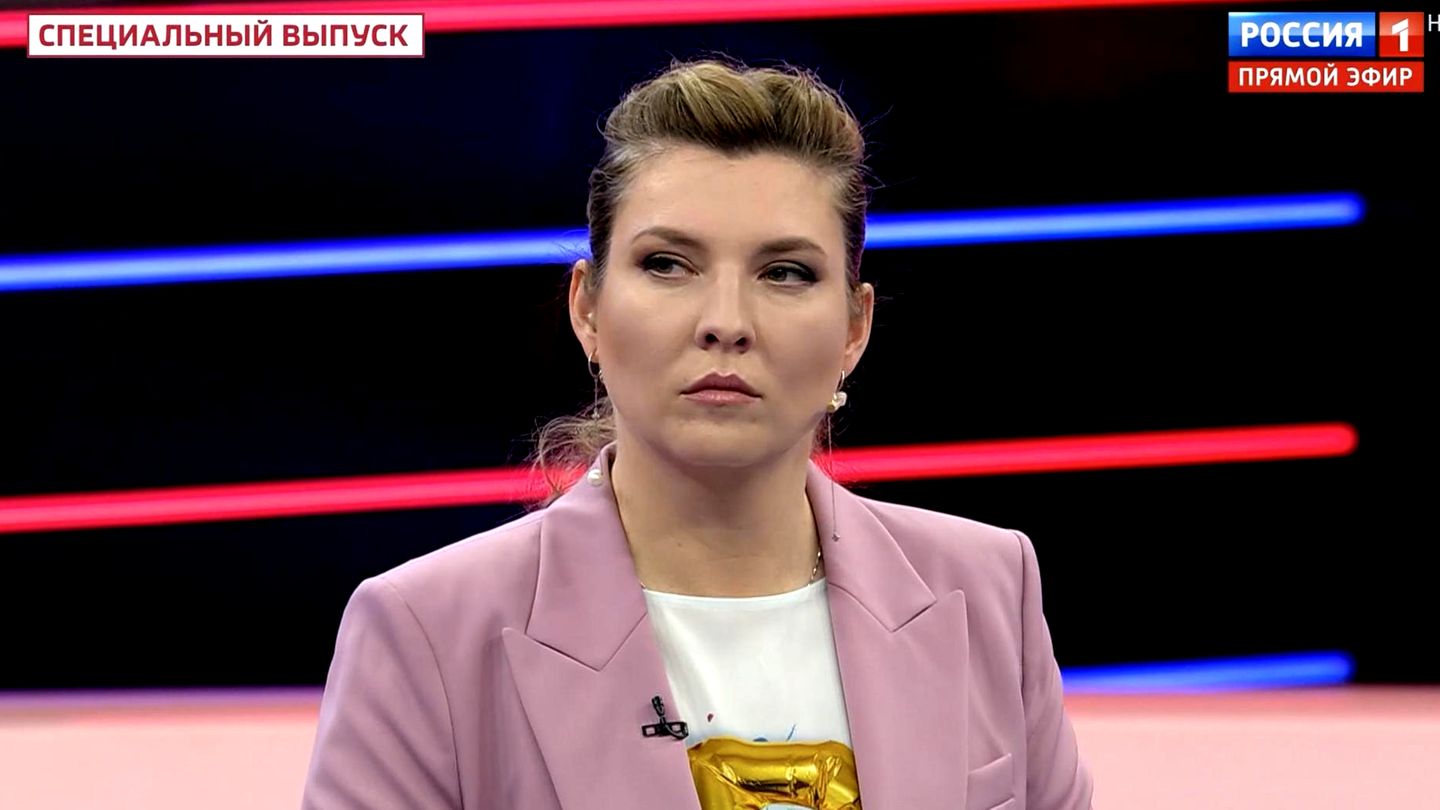On the left bank of the Dnieper, the Ukrainian territories occupied by Russia are under water after the collapse of the Kakhovka dam. However, after the initial furore, the Russian state media pushed the topic into the background. The reason: apparently no instructions have come from the Kremlin.
A few hours after the first reports of the destruction of the Kakhovka dam appeared early Tuesday morning, the Kremlin’s propagandists went to great lengths to present the Russian public with a culprit. “The Ukrainians staged an act of terror and destroyed the massive building of incredible proportions,” announced Olga Skabeeva in her program “60 Minutes” at 12 p.m. local time on one of the country’s most important broadcasters Rossiya 1.
“The most alarming news is reaching us from the Cherson region,” she reported. “Insane pictures. The water level has already risen by ten meters. It’s practically flooded.”
“What Ukraine did there is equivalent in effect to the use of a tactical nuclear weapon,” commented her studio guest Igor Korotschenko on the situation.
A day later, Skabeeva’s husband and co-moderator, Yevgeny Popov, began the program with pictures from the flooded Russian-occupied territories, but then preferred to talk about alleged domestic political problems in the USA and the recruitment difficulties of the German Bundeswehr. A little later, one of his guests philosophized about the alleged drug use in the US armed forces and the US establishment – as if he himself had witnessed this alleged drug use countless times. Almost nothing was to be seen of the effects, which had been compared so dramatically to the use of a nuclear weapon the day before.
Kachowka disaster becomes “flood”
Three days after the Kakhovka disaster unfolded, the issue has faded into the background on the news of Russian state television. In the daily edition of the news program “Vesti” on the channel Rossiya 1 on June 8, the first article was about the Russian troops, who were said to be “successfully repelling” attacks by the Ukrainian armed forces. The flooding of the Kherson region was described later in the program as “a flood after the Ukrainian shelling of the”.
The story repeated itself in the evening edition of “Westi”: First, the destruction of the dam was described as a “barbaric action” by Ukraine. Subsequently, the correspondents of the program announced that there was a “flood” in the Kherson region. NTW news programs also use the same word.
International forum of education ministers becomes the main news
In one of the news programs on Russia’s main channel Pervyy Kanal (First Channel), the subject even moved up to fourth place in the schedule. The article about the catastrophe in the Cherson region was preceded by: a story about an “international forum of education ministers”, a report about western weapons allegedly destroyed at the front and a report about the imprisonment of an alleged “Kiev agent” in Donetsk.
At the same time, the Pervyj Kanal broadcaster did not focus on the causes of the Kakhovka catastrophe. The hydroelectric power station was described as “attacked”. How and who is said to have attacked it was kept from the spectators.
All state channels and propagandistic online media are now putting much more emphasis on the allegedly successful evacuation of the residents of the occupied area. In fact, the Russian authorities reacted much too late. It was not until the evening of June 6 that the Moscow-installed government said a plan to evacuate residents from the flooded area had been “worked out” and that the Ministry of Emergency Situations was ready to evacuate people “if necessary.”
Failed during evacuation
In the past few days, however, residents have reported that no help is in sight. On the contrary: the Russian army should prevent those who do not have Russian passports from leaving the flooded villages and towns. .
The Russian rescue workers only went into action 60 hours after the flood began. While volunteers would try to save people, they would be fired upon by Russian soldiers. Contrary to official claims, the authorities would not keep statistics on how many people are missing or dead. Countless bodies can be seen in the masses of water.
New Kremlin propaganda narrative: “Russia saves and helps”
However, viewers and readers of pro-Kremlin media see a different picture. An employee of a state publication revealed in an interview with “Meduza”: People are told that “Russia saves and helps” and that “Ukraine shoots at those whom Russia helps”.
A source close to the presidential administration (this is where the so-called handbooks for the propaganda media are written) explained the tactic behind it: At the moment it is “not advisable to focus on the causes [der Katastrophe] to focus,” said the anonymous source.
“Essentially a natural disaster”
“The president is officially talking about Ukraine. Shoigu says that Ukraine did it. Dmitry Peskov makes the same statements. That’s enough. It’s better to focus on the positive, also in order not to scare people unnecessarily.” This is the standard procedure, he assures, calling the destruction of the hydroelectric power station “essentially a natural disaster.”
The interlocutor of “Meduza” added that although the disaster was an “important event”, it “does not stand out against the general background of the war.”
“So far the death toll doesn’t go into the dozens,” the source claimed, apologizing for the propaganda tactic. A statement that reveals more about the relationship between the Russian government and its own population than about the actual number of victims. Volunteers are already assuming hundreds of deaths.
Kachowka Dam
Destruction on the Dnipro: “The biggest man-made environmental disaster in Europe for decades”
No instructions from the Kremlin
The renewed reluctance of the Russian state media could also simply have to do with the fact that they have not received any instructions from the Kremlin. . Accordingly, there were no clear recommendations for reporting on the Kachowka disaster. Usually such “manuals” are issued almost immediately after major events. But this time it was different.
According to the two sources, the propagandists were not even told exactly what was to be given as the reason for the dam’s destruction. And so most of the Kremlin media chose to hit the brakes. “You don’t have to pedal, but you don’t have to cover it up either,” one of the interlocutors described the current propaganda approach.
Source: Stern
I have been working in the news industry for over 6 years, first as a reporter and now as an editor. I have covered politics extensively, and my work has appeared in major newspapers and online news outlets around the world. In addition to my writing, I also contribute regularly to 24 Hours World.




